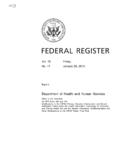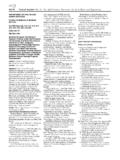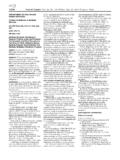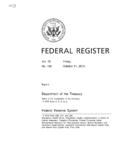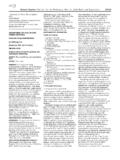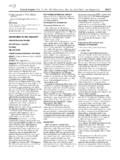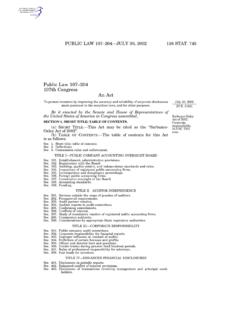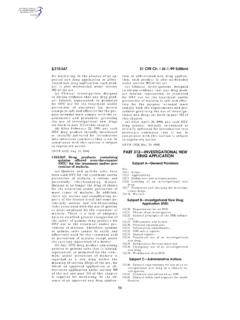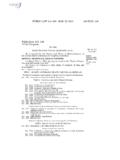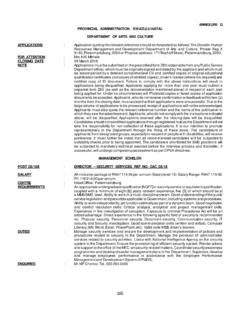Transcription of Federal Register /Vol. 73, No. 149/Friday, August 1, …
1 45029 Federal Register / Vol. 73, No. 149 / friday , August 1, 2008 / Notices All counties within the State of Nebraska are eligible to apply for assistance under the Hazard Mitigation Grant Program. (The following Catalog of Federal Domestic Assistance Numbers (CFDA) are to be used for reporting and drawing funds: , Community Disaster Loans; , Cora Brown Fund; , Crisis Counseling; , Disaster Legal Services; , Disaster Unemployment Assistance (DUA); , Fire Management Assistance Grant; , Disaster Housing Assistance to Individuals and Households In Presidential Declared Disaster Areas; , Presidential Declared Disaster Assistance Disaster Housing Operations for Individuals and Households; Presidential Declared Disaster Assistance to Individuals and Households Other Needs, , Disaster Grants Public Assistance (Presidentially Declared Disasters); , Hazard Mitigation Grant.) R. David Paulison, Administrator, Federal Emergency Management Agency. [FR Doc.]
2 E8 17688 Filed 7 31 08; 8:45 am] BILLING CODE 9110 10 P DEPARTMENT OF HOMELAND SECURITY Federal Emergency Management Agency [FEMA 1780 DR] Texas; Major Disaster and Related Determinations AGENCY: Federal Emergency Management Agency, DHS. ACTION: notice . SUMMARY: This is a notice of the Presidential declaration of a major disaster for the State of Texas (FEMA 1780 DR), dated July 24, 2008 , and related determinations. DATES: Effective Date: July 24, 2008 . FOR FURTHER INFORMATION CONTACT: Peggy Miller, Disaster Assistance Directorate, Federal Emergency Management Agency, Washington, DC 20472, (202) 646 2705. SUPPLEMENTARY INFORMATION: notice is hereby given that, in a letter dated July 24, 2008 , the President declared a major disaster under the authority of the Robert T. Stafford Disaster Relief and Emergency Assistance Act, 42 5121 5206 (the Stafford Act), as follows: I have determined that the damage in certain areas of the State of Texas resulting from Hurricane Dolly beginning on July 22, 2008 , and continuing, is of sufficient severity and magnitude to warrant a major disaster declaration under the Robert T.
3 Stafford Disaster Relief and Emergency Assistance Act, 42 5121 5206 (the Stafford Act). Therefore, I declare that such a major disaster exists in the State of Texas. In order to provide Federal assistance, you are hereby authorized to allocate from funds available for these purposes such amounts as you find necessary for Federal disaster assistance and administrative expenses. You are authorized to provide assistance for emergency protective measures (Category B), including direct Federal assistance, under the Public Assistance program in the designated areas; Hazard Mitigation throughout the State; and any other forms of assistance under the Stafford Act that you deem appropriate subject to completion of Preliminary Damage Assessments (PDAs), unless you determine that the incident is of such unusual severity and magnitude that PDAs are not required to determine the need for supplemental Federal assistance pursuant to 44 CFR (d). Consistent with the requirement that Federal assistance be supplemental, any Federal funds provided under the Stafford Act for Public Assistance and Hazard Mitigation will be limited to 75 percent of the total eligible costs, except for any particular projects that are eligible for a higher Federal cost-sharing percentage under the FEMA Public Assistance Pilot Program instituted pursuant to 6 777.
4 If Other Needs Assistance is later warranted, Federal funding under that program will also be limited to 75 percent of the total eligible costs. Further, you are authorized to make changes to this declaration to the extent allowable under the Stafford Act. The Federal Emergency Management Agency (FEMA) hereby gives notice that pursuant to the authority vested in the Administrator, Department of Homeland Security, under Executive Order 12148, as amended, Sandy Coachman, of FEMA is appointed to act as the Federal Coordinating Officer for this declared disaster. I do hereby determine the following areas of the State of Texas to have been affected adversely by this declared major disaster: Aransas, Bexar, Brooks, Calhoun, Cameron, Hidalgo, Jim Wells, Kenedy, Kleberg, Nueces, Refugio, San Patricio, Starr, Victoria, and Willacy Counties for Public Assistance Category B (emergency protective measures), including direct Federal assistance. All counties within the State of Texas are eligible to apply for assistance under the Hazard Mitigation Grant Program.
5 (The following Catalog of Federal Domestic Assistance Numbers (CFDA) are to be used for reporting and drawing funds: , Community Disaster Loans; , Cora Brown Fund Program; , Crisis Counseling; , Disaster Legal Services Program; , Disaster Unemployment Assistance (DUA); , Fire Management Assistance; , Individual and Household Housing; , Individual and Household Disaster Housing Operations; , Individual and Household Program Other Needs; , Public Assistance Grants; , Hazard Mitigation Grant Program.) R. David Paulison, Administrator, Federal Emergency Management Agency. [FR Doc. E8 17686 Filed 7 31 08; 8:45 am] BILLING CODE 9110 10 P DEPARTMENT OF HOMELAND SECURITY Federal Emergency Management Agency [Docket ID FEMA 2004 0004] [Z RIN 1660 ZA02] Planning Guidance for Protection and Recovery Following Radiological Dispersal Device (RDD) and Improvised Nuclear Device (IND) Incidents AGENCY: Federal Emergency Management Agency, DHS. ACTION: notice of final guidance.
6 SUMMARY: The Department of Homeland Security (DHS) is issuing final guidance entitled, Planning Guidance for Protection and Recovery Following Radiological Dispersal Device (RDD) and Improvised Nuclear Device (IND) Incidents (the Guidance). This Guidance is intended for Federal agencies, State and local governments, emergency management officials, and the general public who should find it useful in developing plans for responding to an RDD or IND incident. The Guidance recommends protective action guides (PAGs) to support decisions about actions that should be taken to protect the public and emergency workers when responding to or recovering from an RDD or IND incident. The Guidance outlines a process to implement the recommendations, discusses existing operational guidelines that should be useful in the implementation of the PAGs and other response actions, and encourages Federal , state and local emergency response officials to use these guidelines to develop specific operational plans and response protocols for protection of emergency workers responding to catastrophic incidents involving high levels of radiation and/or radioactive contamination.
7 DATES: This notice is effective August 1, 2008 . FOR FURTHER INFORMATION CONTACT: Craig Conklin, Director Sector Specific Agency Executive Management Office, Office of Infrastructure Protection, VerDate Aug<31>2005 19:39 Jul 31, 2008 Jkt 214001 PO 00000 Frm 00073 Fmt 4703 Sfmt 4703 E:\FR\FM\ 01 AUN1mstockstill on PROD1PC66 with NOTICES45030 Federal Register / Vol. 73, No. 149 / friday , August 1, 2008 / Notices Department of Homeland Security at 703 235 2850 (phone), or (e-mail), or, John MacKinney, Deputy Director, Nuclear/ Radiological/Chemical Threats and Science and Technology Policy, Office of Policy, Department of Homeland Security, at (202) 447 3885 (phone), or (e-mail). SUPPLEMENTARY INFORMATION: Table of Contents Preface (a) Introduction (b) Characteristics of RDD and IND Incidents (1) Radiological Dispersal Device (RDD) (2) Improvised Nuclear Device (IND) (3) Differences Between Acts of Terror and Accidents (c) Phases of Response (1) Early Phase (2) Intermediate Phase (3) Late Phase (d) Guidance for RDD and IND Incidents (1) Protective Actions (2) Protective Action Guides (PAGs) (3) Early and Intermediate Phase Protective Action Guides for RDD and IND Incidents (A) Early Phase PAGs (B) Intermediate Phase PAGs (4) Late Phase Guidance (5) Emergency Worker Guidance (e) Operational Guidelines for Early and Intermediate PAGs (1) Derived Response Levels (DRLs) (2) Derived Intervention Levels (DILs) for Food (3) Radiation Levels for Control of Access to Radiation Areas Appendix 1.
8 Planning for Protection of Emergency Workers Responding to RDD and IND Incidents (a) Guidelines for Emergency Workers in Responding to RDD and IND Incidents (b) Controlling Occupational Exposures and Doses to Emergency Workers (c) Understanding Radiation Risks (d) Preparedness Appendix 2. Risk Management Framework for RDD and IND Incident Planning (a) The Stages of the Risk Management Framework for Responding to RDD and IND Incidents (1) Define the Problems and Put Them in Context (2) Analyze the Risks (3) Examine the Options (4) Make a Decision (5) Take Action To Implement Decision (6) Evaluate the Results (b) Technical Advisory Committee Appendix 3. Federal Cleanup Implementation Cleanup Activities Overview (a) General Management Structure (1) Technical Working Group (2) Stakeholder Working Group (b) Activities (1) Optimization and Recommendation (2) Public Review of Decision (3) Execute Cleanup Appendix 4. Operational Guidelines for Implementation of Protective Action Guides and Other Activities in RDD or IND Incidents (a) Group A: Access Control During Emergency Response Operations (b) Group B: Early Phase Protective Action (Evacuation or Sheltering) (c) Group C: Relocation and Critical Infrastructure Utilization in Affected Areas (d) Group D: Temporary Access to Relocation Areas for Essential Activities (e) Group E: Transportation and Access Routes (f) Group F: Release of Property From Radiologically Controlled Areas (g) Group G: Food Consumption (h) Derivation of Operational Guidelines Appendix 5.
9 References Appendix 6. Acronyms/Glossary Background This Guidance was developed to address the critical issues of protective actions and protective action guides (PAGs) to protect human health and to mitigate the effects caused by terrorists use of a Radiological Dispersal Device (RDD) or Improvised Nuclear Device (IND). This document provides guidance for site cleanup and recovery following an RDD or IND incident, and affirms the applicability of existing 1992 EPA PAGs for radiological emergencies. The development of this Guidance was directed by the White House, Office of Science and Technology Policy, through the National Science and Technology Council, Committee on Homeland and National Security, Subcommittee on Standards (SoS). In 2003, the SoS convened a senior level Federal working group, chaired by DHS, to develop guidance for response and recovery following a radiological dispersal device (RDD) or improvised nuclear device (IND) incident. The working group consisted of senior subject matter experts in radiological/ nuclear emergency preparedness, response, recovery, and incident management.
10 The following Federal departments and agencies were represented on the working group: DHS, EPA, Department of Commerce (DOC), Department of Energy (DOE), Department of Defense (DOD), Department of Labor (DOL), Department of Health and Human Services (HHS), and Nuclear Regulatory Commission (NRC). On January 3, 2006, DHS issued the Preparedness Directorate; Protective Action Guides for Radiological Dispersal Device (RDD) and Improvised Nuclear Device (IND) Incidents; notice (71 FR 174, Jan. 3, 2006), and requested public comments on this interim Guidance. Some changes to the Guidance were made as a result of these comments. A summary of the comments on the interim Guidance document and responses are available at Docket ID No. FEMA 2004 0004 at http:// In addition to the issuance of this Guidance, in response to interagency working group discussions and public comments, further guidance will be provided for the consequences that would be unique to an IND attack.
